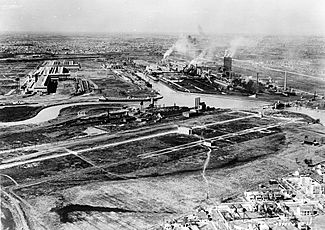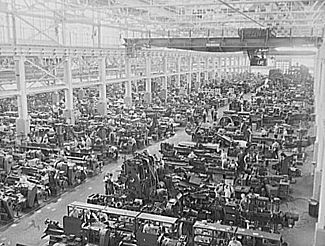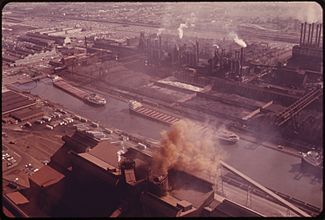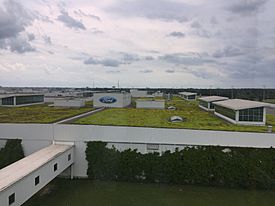Ford River Rouge Complex facts for kids
|
Ford River Rouge Complex
|
|

Aerial view of the Rouge Complex in 1927
|
|
| Lua error in Module:Location_map at line 420: attempt to index field 'wikibase' (a nil value). | |
| Location | Dearborn, Michigan |
|---|---|
| Area | 900 acres (360 ha) (landmarked area) |
| Built | 1917–1928 |
| Architect | Albert Kahn |
| Visitation | 148,000 (2017) |
| NRHP reference No. | 78001516 |
Quick facts for kids Significant dates |
|
| Added to NRHP | June 2, 1978 |
| Designated NHLD | June 2, 1978 |
The Ford River Rouge Complex (often called the Rouge Complex or The Rouge) is a huge Ford Motor Company car factory in Dearborn, Michigan. It sits along the River Rouge, close to where it meets the Detroit River. Building this massive factory started in 1917. When it was finished in 1928, it became the largest factory in the world.
The Rouge Complex was so impressive that it inspired other big factories around the globe. These included the Renault factory in France and the GAZ factory in the Soviet Union. Later, the Hyundai factory in South Korea also took ideas from the Rouge. The famous architect Albert Kahn designed many parts of the Rouge. Because of its amazing design and importance to American industry, it was named a National Historic Landmark District in 1978.
Contents
What Makes the Rouge Complex Special?
The Rouge Complex is enormous, covering about 1.5 miles (2.4 km) wide and 1 mile (1.6 km) long. It has 93 buildings with almost 16 million square feet (1.5 km²) of factory space. Imagine a factory with its own docks on the dredged Rouge River! It also has 100 miles (160 km) of railroad tracks inside.
The complex even had its own electricity plant and an integrated steel mill. This meant it could take raw materials like iron ore and turn them into finished cars all in one place. This way of working is called vertical integration. At its peak, over 100,000 people worked there, even during the Great Depression in the 1930s.
Many buildings at the Rouge were designed by architect Albert Kahn. His glass plant at the Rouge was known for being a great place to work. It had lots of natural light coming through windows in the ceiling. In recent years, some buildings at the Rouge have been updated. They now have "green" features that are good for the environment.
In 1932, a famous Mexican artist named Diego Rivera visited the Rouge. He studied the factories and used what he saw to create his amazing murals. These murals are called Detroit Industry and you can see them at the Detroit Institute of Arts.
Cars and More: What Was Made at the Rouge?
The first things made at the Rouge were Eagle Boats. These were World War I boats used to fight submarines. After the war, the factory started making Fordson tractors. While the Rouge made almost all the parts for the Ford Model T, the final assembly of the Model T happened at another plant.
It wasn't until 1927 that car production began at the Rouge. The first car made there was the Ford Model A. During World War II, the Rouge complex was very important. It produced jeeps, aircraft engines, and many other parts for the war effort.
Over the years, the Rouge made many famous Ford vehicles. These included the 1932 Model B, the first Mercury cars, the Ford Thunderbird, and the Mercury Capri. For four decades, the Rouge was also where many Ford Mustangs were built. The old assembly plant closed down when a new one was built. This new plant now makes Ford F-150 pickup trucks.
The Rouge Complex used to make almost every part for Ford vehicles. Many vehicles were put together into "knock-down kits." These kits were then sent by train to other places across the United States to be assembled. After the 1960s, Ford started building more factories in different cities. The Rouge became smaller, and some of its parts, like the furnaces, were sold to other companies.
On May 26, 1937, a group of workers tried to form a union at the Rouge. This event became known as the Battle of the Overpass. It was a difficult time for workers trying to gain rights.
The Rouge was one of only three places where Ford made the Mustang. In 1987, Ford planned to stop making the Mustang and replace it with a different car. But people loved the Mustang so much that sales went up! This helped save the Rouge. Ford then decided to make the factory more modern.
On February 1, 1999, there was an accident at the power plant. Six employees died, and many more were hurt. A new, modern power plant was built to replace it. The original Dearborn Assembly Plant closed on May 10, 2004. The last car made there was a red 2004 Ford Mustang GT. The old plant was taken down by 2008. Now, a large parking lot stands where it used to be.
The Ford Rouge Center Today
Today, the Rouge site is known as the Ford Rouge Center. It's like a big industrial park with six Ford factories. It also has steelmaking operations run by AK Steel, another company. The new Dearborn Truck factory is famous for its special vegetation-covered roof. It also has a rainwater collection system. These features were designed by sustainability architect William McDonough.
The Rouge Center is still Ford's largest factory. About 6,000 people work there. However, Mustang production has moved to another plant in Flat Rock, Michigan.
For many years, people could take tours of the Rouge complex. Free bus tours started in 1924 and ran until 1980. At their busiest, about a million visitors came each year! Tours started again in 2004 with The Henry Ford Museum. Visitors can now see multimedia shows and watch cars being assembled. In 2017, 148,000 people visited the Ford Rouge Factory Tour.
Workers at the Ford and AK Steel facilities at the complex are part of the UAW Local 600 union. Ford also had a fleet of three large ships that carried materials on the Great Lakes. These ships were named after Ford family members and executives. When the ships were retired, parts of them were moved to museums or turned into homes.
Eco-Friendly Design: Renovated Architecture
In 1999, architect William McDonough worked with Ford to redesign the Rouge River facility. The roof of the 1.1 million square foot (100,000 m2) Dearborn truck assembly plant was covered with over 10 acres (4.0 ha) of sedum. Sedum is a low-growing plant that covers the ground.
This special roof helps the environment in several ways. It holds and cleans rainwater, which is then reused. It also helps keep the building cooler in summer and warmer in winter, saving energy. This roof is part of an $18 million system that collects and cleans rainwater every year. This system saved Ford from having to build a much more expensive water treatment facility.
What's Made There Now?
- Ford F-150 (1948–present)
What Was Made There Before?
- Ford Mustang (1964–2004)
- Mercury Capri (1979–1986)
- Mercury Cougar (1966–1973)
Images for kids
-
President Joe Biden during his visit to the Ford Rouge Electric Vehicle Center in 2021
See also
 In Spanish: Ford River Rouge Complex para niños
In Spanish: Ford River Rouge Complex para niños





